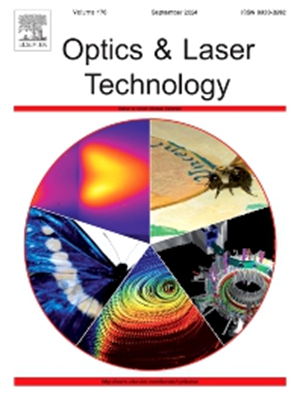Brillouin microcomb multiplexing in magnesium fluoride microbottle resonators
IF 4.6
2区 物理与天体物理
Q1 OPTICS
引用次数: 0
Abstract
Backward stimulated Brillouin scattering has a wide range of applications in optics and microwave photonics. In this paper, we realize a Brillouin microcomb multiplexing in magnesium fluoride microbottle resonators by generating a stable Brillouin laser and axial two-dimensional frequency combs in the resonator. The magnesium fluoride microbottle resonator is equipped with numerous higher-order mode families with a quality factor as high as 108. These advantages result in an effective multiplexed Kerr microcombs and Brillouin axial Kerr microcombs with comb bandwidths of up to 60 nm by varying the detuning conditions by adjusting the pump power. The magnesium fluoride microbottle resonators provide a new optical platform for practical applications in frequency conversion, comb metrology, and spectroscopy. The multiplexing approach may lead to significant simplification and flexible method in achieving comb interferometry and the deployment of the multi-comb based on microresonator.
求助全文
约1分钟内获得全文
求助全文
来源期刊
CiteScore
8.50
自引率
10.00%
发文量
1060
审稿时长
3.4 months
期刊介绍:
Optics & Laser Technology aims to provide a vehicle for the publication of a broad range of high quality research and review papers in those fields of scientific and engineering research appertaining to the development and application of the technology of optics and lasers. Papers describing original work in these areas are submitted to rigorous refereeing prior to acceptance for publication.
The scope of Optics & Laser Technology encompasses, but is not restricted to, the following areas:
•development in all types of lasers
•developments in optoelectronic devices and photonics
•developments in new photonics and optical concepts
•developments in conventional optics, optical instruments and components
•techniques of optical metrology, including interferometry and optical fibre sensors
•LIDAR and other non-contact optical measurement techniques, including optical methods in heat and fluid flow
•applications of lasers to materials processing, optical NDT display (including holography) and optical communication
•research and development in the field of laser safety including studies of hazards resulting from the applications of lasers (laser safety, hazards of laser fume)
•developments in optical computing and optical information processing
•developments in new optical materials
•developments in new optical characterization methods and techniques
•developments in quantum optics
•developments in light assisted micro and nanofabrication methods and techniques
•developments in nanophotonics and biophotonics
•developments in imaging processing and systems

 求助内容:
求助内容: 应助结果提醒方式:
应助结果提醒方式:


